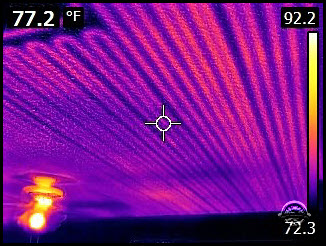Hot Heads- Radiant Ceiling Heat

Feeling hot headed? Do you have a radiant electric ceiling?

The main principle with electric radiant heat coils in the ceiling to deliver heat via infrared radiation to objects and people in the rooms being served by these systems. Remember heat does not rise only warm air rises which leads many people to think that heat rises. Heat always will transfer from a warmer object to a cooler object. In the world of physics basically everything has heat that is above absolute zero.
(Absolute zero is defined as; 0 K on the Kelvin scale, which is a thermodynamic (absolute) temperature scale; –273.15 degrees Celsius on the Celsius scale; and −459.67 °F on the Fahrenheit scale.)
Since the ceiling will be of a higher temperature it will radiate heat energy to all objects in the room that are at a lower temperature trying to achieve a state of thermal equilibrium.

Radiant ceiling heat was real popular typically into the 1960’s in the Greater Wenatchee and Chelan area.
These systems can create some planning issues if you are thinking of doing work on the ceiling such as adding lights or hanging items from the ceiling. You do not want to damage the system.
Typically there were 3 methods of installation for ceiling radiant systems.
The First; Ceiling and walls are hung and finished. Electricians will install ceiling heat cables. After the cables are installed often 2 coats of a plaster (such as a product called RADEX) will be applied over the cables, then a texture as planned.
From the Manufacturer- “Radex Is A Very Low-density, Free-flowing Powder, Formulated To Reduce Heat Loss To A Minimum.”

The second method was to hang a layer of drywall on ceilings only. Tape flat joints. Then Electricians will install the cables. Hangers then roll joint compound over cables and hang a 2nd layer of drywall on ceiling then they will hang the walls.
The third method was to hang a drywall product on the ceiling called Panelectric, which is a 5/8″ drywall panel with the cables installed within the core of the board.
Proper planning will be involved using this system because you will filler panels to install ceiling fixtures. All non-electrical openings will need to be at least 2 inches away from the nearest heating cable and for electrical boxes and lights you need to be 8 inches away from the nearest cables.

TFor more information on Panelectric use the links below.
http://www.panelectricheat.com/page/401791994
http://www.panelectricheat.com/page/401790190
If you are in the Greater Wenatchee area and plan on doing some work to your ceiling that has radiant system installed and need an IR (Infrared) scan to see where your radiant ceiling elements are please do not hesitate to call NCW Home Inspection to help you map out your needs.
If you find any errors or have additional information that would expand on any code, building standards or manufacturer requirements please let me know.
NCW Home Inspections, LLC is a Licensed Washington State Home Inspection service located in Wenatchee Washington serving Chelan County, Douglas County, Kittitas County, Okanogan County and Grant County Washington and the cities of Wenatchee, Leavenworth, Cashmere, Oroville, Cle Elum, East Wenatchee, Quincy and many more…
Your Wenatchee and Chelan Professional Real Estate, Home and Structural Pest Inspection Service
Coordinator & Instructor- Fundamentals of Home Inspection- Bellingham Technical College
Former WA Home Inspector Advisory Licensing Board
www.ncwhomeinspections.com 509-670-9572
You can follow me on Facebook, Twitter, Google+ and on my website Blog.
(Click on Icons to go to social media pages.)




